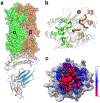Engineering the T cell receptor for fun and profit: Uncovering complex biology, interrogating the immune system, and targeting disease
- PMID: 35344834
- PMCID: PMC9189011
- DOI: 10.1016/j.sbi.2022.102358
Engineering the T cell receptor for fun and profit: Uncovering complex biology, interrogating the immune system, and targeting disease
Abstract
T cell receptors (TCRs) orchestrate cellular immunity by recognizing peptide antigens bound and presented by major histocompatibility complex (MHC) proteins. Due to the TCR's central role in immunity and tight connection with human health, there has been significant interest in modulating TCR properties through protein engineering methods. Complicating these efforts is the complexity and vast diversity of TCR-peptide/MHC interfaces, the interdependency between TCR affinity, specificity, and cross-reactivity, and the sophisticated relationships between TCR binding properties and T cell function, many aspects of which are not well understood. Here we review TCR engineering, starting with a brief historical overview followed by discussions of more recent developments, including new efforts and opportunities to engineer TCR affinity, modulate specificity, and develop novel TCR-based constructs.
Copyright © 2022 Elsevier Ltd. All rights reserved.
Conflict of interest statement
Conflict of interest statement Nothing to declare.
Figures


Similar articles
-
Dynamical footprint of cross-reactivity in a human autoimmune T-cell receptor.Sci Rep. 2017 Feb 14;7:42496. doi: 10.1038/srep42496. Sci Rep. 2017. PMID: 28195200 Free PMC article.
-
Structural and dynamic control of T-cell receptor specificity, cross-reactivity, and binding mechanism.Immunol Rev. 2012 Nov;250(1):10-31. doi: 10.1111/j.1600-065X.2012.01165.x. Immunol Rev. 2012. PMID: 23046120 Review.
-
MPID-T: database for sequence-structure-function information on T-cell receptor/peptide/MHC interactions.Appl Bioinformatics. 2006;5(2):111-4. doi: 10.2165/00822942-200605020-00005. Appl Bioinformatics. 2006. PMID: 16722775
-
T cell antigen receptor recognition of antigen-presenting molecules.Annu Rev Immunol. 2015;33:169-200. doi: 10.1146/annurev-immunol-032414-112334. Epub 2014 Dec 10. Annu Rev Immunol. 2015. PMID: 25493333 Review.
-
T Cell Receptor Engineering and Analysis Using the Yeast Display Platform.Methods Mol Biol. 2015;1319:95-141. doi: 10.1007/978-1-4939-2748-7_6. Methods Mol Biol. 2015. PMID: 26060072 Free PMC article.
Cited by
-
Focusing on CD8+ T-cell phenotypes: improving solid tumor therapy.J Exp Clin Cancer Res. 2024 Sep 28;43(1):266. doi: 10.1186/s13046-024-03195-5. J Exp Clin Cancer Res. 2024. PMID: 39342365 Free PMC article. Review.
-
Exploring the potential of structure-based deep learning approaches for T cell receptor design.PLoS Comput Biol. 2024 Sep 30;20(9):e1012489. doi: 10.1371/journal.pcbi.1012489. eCollection 2024 Sep. PLoS Comput Biol. 2024. PMID: 39348412 Free PMC article.
-
Exploring the Potential of Structure-Based Deep Learning Approaches for T cell Receptor Design.bioRxiv [Preprint]. 2024 Apr 24:2024.04.19.590222. doi: 10.1101/2024.04.19.590222. bioRxiv. 2024. Update in: PLoS Comput Biol. 2024 Sep 30;20(9):e1012489. doi: 10.1371/journal.pcbi.1012489. PMID: 38712216 Free PMC article. Updated. Preprint.
-
Enhanced T cell receptor specificity through framework engineering.Front Immunol. 2024 Mar 12;15:1345368. doi: 10.3389/fimmu.2024.1345368. eCollection 2024. Front Immunol. 2024. PMID: 38545094 Free PMC article.
-
T cell receptor therapeutics: immunological targeting of the intracellular cancer proteome.Nat Rev Drug Discov. 2023 Dec;22(12):996-1017. doi: 10.1038/s41573-023-00809-z. Epub 2023 Oct 27. Nat Rev Drug Discov. 2023. PMID: 37891435 Free PMC article. Review.
References
-
- Manning TC, Schlueter CJ, Brodnicki TC, Parke EA, Speir JA, Garcia KC, Teyton L, Wilson IA, Kranz DM: Alanine scanning mutagenesis of an alphabeta T cell receptor: mapping the energy of antigen recognition. Immunity 1998, 8:413–425. - PubMed
-
- Davis MM, Boniface JJ, Reich Z, Lyons D, Hampl J, Arden B, Chien Y: Ligand recognition by alpha beta T cell receptors. Annu Rev Immunol 1998, 16:523–544. - PubMed
-
- Li Y, Moysey R, Molloy PE, Vuidepot A-L, Mahon T, Baston E, Dunn S, Liddy N, Jacob J, Jakobsen BK, et al.: Directed evolution of human T-cell receptors with picomolar affinities by phage display. Nat Biotech 2005, 23:349–354. - PubMed
-
- Laugel B, Boulter JM, Lissin N, Vuidepot A, Li Y, Gostick E, Crotty LE, Douek DC, Hemelaar J, Price DA, et al.: Design of soluble recombinant T cell receptors for antigen targeting and T cell inhibition. J Biol Chem 2005, 280:1882–1892. - PubMed
Publication types
MeSH terms
Substances
Grants and funding
LinkOut - more resources
Full Text Sources
Research Materials

